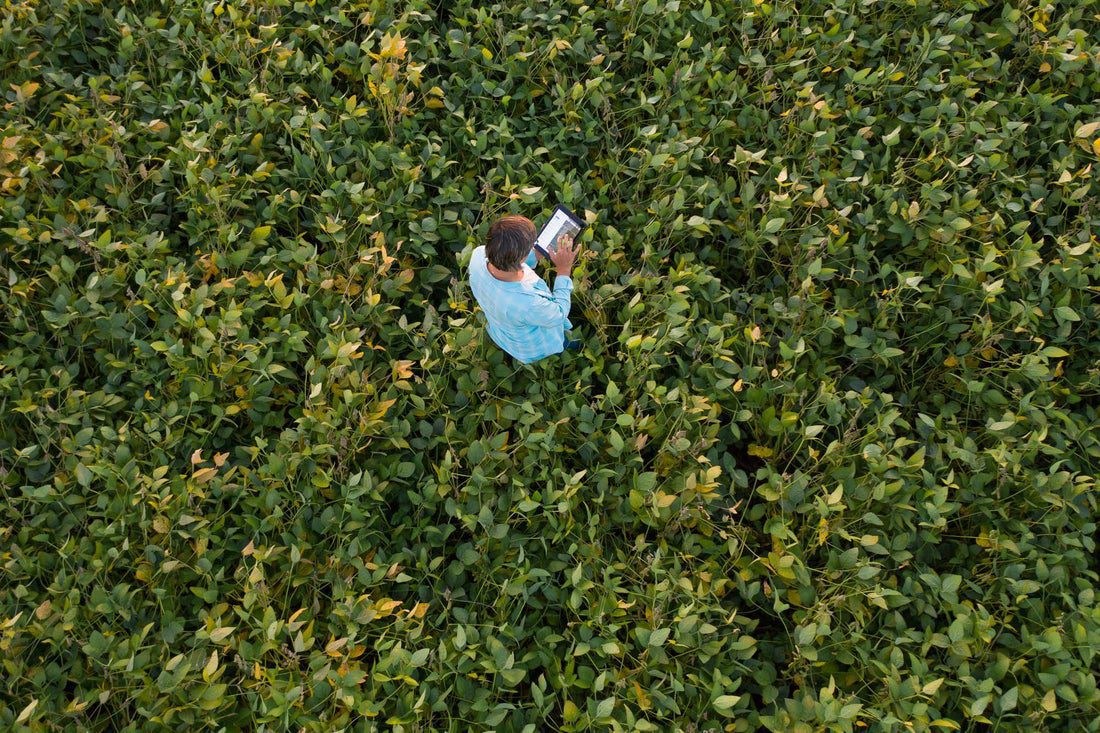Innovative U.S. Soybean Farming and Agriculture Technology
Did you know that since 1980, U.S. soybean farmers have improved land use efficiency by 48%? Their commitment to food security and environmental sustainability ensures that we have healthy food choices now and for future generations. They provide us with protein-rich soy while minimizing water waste, environmental degradation, and soil erosion.
To do so, they use cutting-edge agricultural technology that lets them grow nutrient-dense crops while also protecting our environment’s health. In fact, in 2015 alone, U.S. soybean farmers used biotechnology to reduce carbon dioxide emissions by 58.8 billion pounds. Learn how U.S. soybean farmers are leveraging advanced agricultural technology and systems into their farming practices to adapt to our evolving environmental and food needs.
Emerging Farming Technologies and Systems
Cover Cropping
U.S. Soybean farmers use a technique called cover cropping to improve their soil and its surrounding ecosystem. In a cover crop system, farmers plant a mixture of beneficial seeds with the purpose of renewing the soil after the main crop is harvested. The seed mix includes species that protect the soil, prevent runoff, and slow water movement across the field.
Smart Irrigation and Center-Pivot Systems
Healthy soil and effective water conservation would not be possible if U.S. soybean farmers didn’t use smart irrigation and center pivot systems. These systems help deliver the precise amount of water needed to grow healthy, nutrient dense soy, while using fewer resources. Soil moisture sensors, weather sensors and GPS analyze moisture levels and weather patterns, so U.S. farmers can cultivate soy as efficiently as possible. These systems can be monitored remotely with smartphones, tablets and computers, so farmers can properly nourish soybeans – promoting healthy soil and environmental sustainability, from their fields to our kitchen tables.
Conservation Tillage
U.S. soybean farmers are achieving more with less by planting fields using minimal or no tillage techniques. By adopting conservation tillage, soybean farmers reduce soil disturbance, which helps enhance nutrient retention and biodiversity. This method also reduces soil erosion and greenhouse gas (GHG) emissions. Over 74% of soybean acres are cultivated using conservation tillage, demonstrating how readily U.S. soybean farmers have embraced this eco-friendly farming practice.
What does this mean for you? Well, quite simply: when you choose U.S. grown soy-based foods, you can be confident that U.S. soybean farmers are committed to sustainable farming practices that ensure the long-term health of our planet.
Buffer Strips, Windbreaks, and Agroforestry
Buffer strips and windbreaks are vital parts of sustainable farming. They act like natural fences, keeping soil and water safe. These vegetative buffers are strategically placed near water and around fields to stop soil and nutrients from washing away when it rains, also referred to as run off. By doing this, they reduce soil erosion and nutrient loss. When used with other management water systems, these “natural fences” keep water clean and help soybean farms last a long time.
Farmers also use agroforestry to serve a similar function. By planting trees alongside crops, they improve the soil, increase biodiversity, and sequester carbon.
Precision Agriculture
Precision agriculture revolutionizes soybean farming with technology. Using GPS and sensors, farmers can monitor their fields closely. They can plan when to plant and harvest while using less resources, helping to sustain our environment’s health.
Plant Breeding and Biotechnology
Herbicides are important for high crop yields, as they remove pesky weeds competing with soybeans for sunlight and other resources. To provide enough crops to feed communities across the country, U.S. soybean farmers use emerging biotechnology and plant breeding technology to help improve weed control without harming the soil.
For example, biotech soybean crops are herbicide resistant and come packed with nutritional benefits. By planting herbicide-tolerant soybeans, farmers can control weeds without ploughing deep into the soil to bury them, which can erode topsoil.
U.S. Soybean Farmers’ Dedication to Sustainability
Technological innovations and sustainable practices embraced by U.S. soybean farmers showcase their dedication to sustainable and environmentally conscious farming.
That’s why U.S. Soy has teamed up with reputable partners like Texas Tech University and the Southern Soybean Research Program to reduce the impact drought has on soybean crops, which could potentially improve crop yields by 10-15%. Through advanced farming technologies in water management, nutrient conservation, soil management, precision agriculture, plant breeding, and biodiversity, these farmers are not just producing food—they are ensuring the well-being of our planet for current and future generations.
You can rest assured that when you choose U.S.-grown soy products, you’re supporting a system that prioritizes food security, environmental health, and sustainable development.
To understand how U.S. Soy fosters partnerships and innovation in farming technologies for environmental sustainability, learn more from U.S Soy’s Sustainability report.
